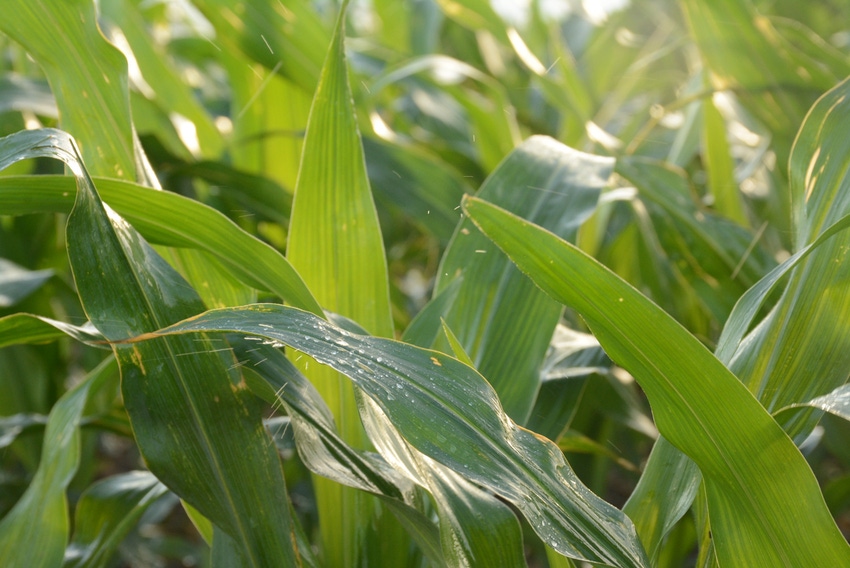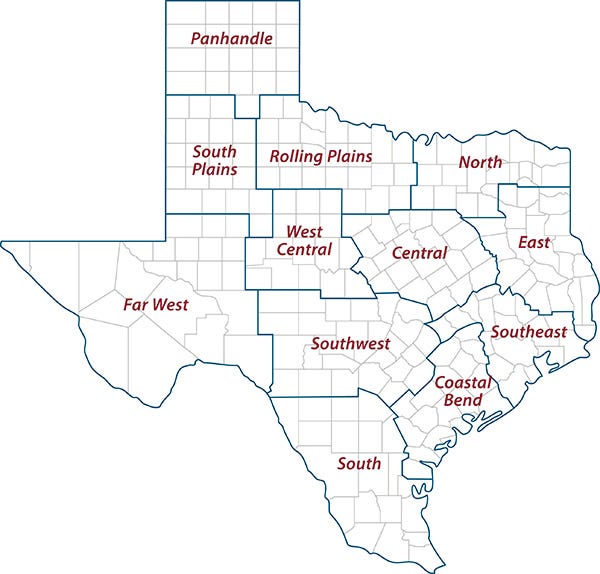
A full soil moisture profile and tightened supplies could mean a good year for grain growers, if they can get their crops planted in time, according to Texas A&M AgriLife Extension Service experts.
Dr. Mark Welch, AgriLife Extension economist, College Station, said the U.S. Department of Agriculture released a report showing national corn supplies carried over from 2018 were lower than expected. The U.S. typically carries 15-20 percent of the national crop into the next growing season.
The report estimated the U.S. corn stock was at 12 percent, Welch said.
“The carryover corn stock has been going down the last three years,” he said. “At 12 percent, that’s tight. If we get to 10 percent, that’s tight, tight and an indication that without record yields we need more corn acres.”
Prices have moved lower despite the report of lower supplies, Welch said. Domestic corn use estimates were lowered by USDA as well, which offsets some impact of the lower production numbers.
“Prices actually went down after the report came out,” he said. “We would think in the context of supply and demand there would be some degree of support for higher prices, but that hasn’t happened so far.”
Welch said uncertainty due to ongoing trade talks with China, specifically soybean exports, could be dampening a positive reaction within the corn market. Soybeans and cotton remain competitive crops for growers to consider as corn lingers just below $4 per bushel.
Wet weather across much of Texas and the Corn Belt in the Midwest could further exacerbate the nation’s corn supply, he said.
“The short-term problem for producers is being able to do field work and prepare for planting,” he said. “We have a good moisture profile that could support above-normal yields, but they still have to get the crop in the ground.”
Welch said conditions have been cold and wet throughout much of the Midwest and producers are well behind on tillage and fertilizer schedules.
FIELD CONDITIONS
Dr. Ronnie Schnell, AgriLife Extension state cropping systems specialist, College Station, said planting in South Texas and drier fields along the Gulf Coast is well underway. But fieldwork remains at a standstill in much of Texas’ corn and sorghum country due to wet conditions.
Schnell said producers are preparing fields as conditions allow but that rain has caused delays since late fall. Unharvested crops still remain in many fields.
“Field conditions are better for Corpus Christi and south to the Rio Grande Valley, but there are a lot of fields north of Victoria over to Houston and throughout Central Texas that are too wet to access,” he said. “Some preplant activities such as herbicide applications have occurred. Sprayers were leaving tracks, but producers are doing what they can where they can.”
Producers need warmer, sunny conditions to dry fields enough to prepare seedbeds and plant, Schnell said. Soil temperatures 50 degrees or higher and several days of warm weather are needed for acceptable germination of corn and sorghum.
“You want to make sure soil temperature is adequate, and there aren’t any cold fronts forecasted when planting early,” he said. “Planting early is better than late, within reason. For early plantings you run the risk of frost or lethal freeze events.
“Light frost at early vegetative stages usually will not cause much, if any, yield loss,” he said. “Multiple frost events or lethal freeze events can cause significant yield loss. But if you plant too late, you run the risk of plants pollinating and filling grain when it’s hot and moisture is often limited. That’s not good either.”
AgriLife Extension district reporters compiled the following summaries:

The 12 Texas A&M AgriLife Extension Districts
CENTRAL: The district received rainfall and some wintry mix. Farmers were able to access fields to plow and fertilize. Supplemental feeding was necessary for livestock on rangelands. Livestock turned out on early winter grazing were in excellent condition. Other winter forage crops emerged and were producing. Soil temperatures were below 50 degrees, and corn planting was expected to begin next week. Wheat improved with fertilizer applications. Some fruit and ornamental trees were blooming. Cattle were in good condition, and stock tanks were full. Nearly all counties reported good soil moisture and good overall rangeland and pasture conditions.
ROLLING PLAINS: The reporting period started much warmer with humidity and heavy dews before temperatures turned much colder. Winter wheat looked good but needed moisture. Pastures and rangelands were in fair to good condition with pastures in some areas greening up. Some cattle were receiving supplemental feed and hay. Cotton producers were still trying to finish the cotton harvest.
COASTAL BEND: Topsoil and subsoil moisture levels were above average. Some corn was planted in the southern end of the district, while wet soil conditions continued to delay most row crop fieldwork. Some farmers were exchanging corn seed for cotton seed. Pastures were saturated and supplemental livestock feeding continued. Producers reported difficulties finding dry spots for protein and/or hay. Livestock were doing well.
EAST: Temperatures went from hot to cold. Storms continued rolling through areas of the district. Shelby County received a wintery mix. Creeks were full and flooding was reported in some areas. Pasture and rangeland conditions were mostly fair to good. Shelby, Marion, Henderson and Angelina counties reported poor to very poor conditions. Subsoil and topsoil conditions were adequate and surplus. Anderson County reported no field activity due to wet conditions. Large quantities of rain were keeping producers from getting into fields and pastures in most counties. Warmer temperatures helped winter grasses. Plants started to bloom in some areas, and producers were preparing to plant spring gardens. Many producers in Cherokee County were running low or out of hay and scrambling to find supplies. Producers were feeding hay and feed to livestock. The cattle market in Houston County was stronger. Shelby County reported good numbers at the sale barn with steady prices. Wild hogs continued to cause damage across the district.
SOUTH PLAINS: Subsoil and topsoil moisture levels were very dry. Pasture, rangeland and winter wheat conditions were poor to fair due to high winds and lack of moisture. Temperatures ranged from 19 degrees to 75 degrees. Producers were prepping for spring planting. Cattle were in good condition.
PANHANDLE: Conditions were cold and dry. Parts of the district were desperate for moisture. Producers in multiple counties resorted to supplementing cattle diets due to pasture conditions. Wildfires were reported in several counties. Most all of the cotton had been taken to gins, where processing continued. No other farming activity was reported.
NORTH: Soil moisture was adequate to surplus across the district. Temperatures were in the high 70s before a cold front moved in. Sporadic rains brought 0.25 of an inch to 2 inches. Wet conditions continued with 120-plus days since consistent moisture events began. Pastures and fields were holding water in some areas. Several warm days helped dry things a bit, but more rain was forecast. Quite a bit of cotton remained in fields, while some was harvested during the warm weather. Producers had very few windows of opportunity to plant wheat and oats, but many fields were planted. Winter forages did not look good but could rebound with sun and warmer temperatures. Wheat and oat harvests were not expected to be as good as last year’s. Stocker cattle were receiving hay. Hay prices were high, and protein and energy quality were inconsistent. Supplements were being provided to meet livestock nutrition needs. Some cows were calving.
FAR WEST: Temperatures ranged from highs in the 80s to lows in the high 20s. Scant amounts of rain were received. Ground preparations for the upcoming season were in progress. Topsoil dried enough for producers to access most fields. Soil moisture levels were good. Wheat, oats and winter forage emerged. Grasses were dormant from cold temperatures, but warmer days resulted in a green up. Cattle received supplemental feed. Pre-emergent herbicides needed to be applied in fields. Fertilizer for pecan trees was needed.
WEST CENTRAL: Conditions were warm and dry but turned cold. Cotton harvest continued due to unusually wet weather in previous reporting periods. Harvest was expected to wrap up in a couple weeks without weather delays. Local cotton gins expected to finish up by mid-March. Winter wheat was in mostly good condition. Many acres were planted late due to weather but should be OK. Some fields were not planted due to wet weather. Producers were expected to plant alternative crops on those acres. Rangeland and pastures were in fair to good condition. Cool-season forages and grasses were in good condition. Demand for cattle was good in a very active market. Choice calves sold $10 higher per hundredweight. Stocker and feeder steers and heifers sold steady. Packer cows were $3 higher per hundredweight, and bulls were $1 higher. Pairs and bred cows were steady.
SOUTHEAST: Livestock were in fair to good condition. Extremely wet conditions persisted, and much of the fieldwork was not completed yet. Row crop producers were behind. Recent and predicted rains likely mean it could be at least March before anything was planted. Many acres expected to be planted in corn will likely be planted in sorghum or cotton. Home gardeners were preparing to plant, but most soils were too wet to work. Grimes County reported several livestock producers lost a large number of calves to predation and suspect a mountain lion caused those losses. Rangeland and pasture ratings were excellent to very poor with poor being most common. Soil-moisture levels ranged from adequate to surplus with surplus being most common.
SOUTHWEST: Cloudy and wet conditions persisted. Temperatures were below freezing in the morning and into the low 80s during the day. Winter grasses were greening. Rangeland and pasture conditions were good. Livestock were in fair condition. Some supplemental feeding continued.
SOUTH: Northern and western parts of the district reported mild weather with short to adequate soil moisture levels. Eastern parts of the district reported cooler weather with some rainfall and adequate soil moisture. Southern parts reported cold weather and short moisture conditions. Potato planting continued. Wheat fields were in good to excellent condition. Pasture and rangeland conditions were poor to fair. Pastures in milder areas were starting to green up. Cattle and wildlife were chasing green growth of winter annuals. Supplemental feeding continued at a steady pace. Most cattle herds began calving. Body condition scores on cattle remained fair. Coastal Bermuda grass fields were still dormant. Crop fields were being prepared for the growing season. Some fields and seedbeds were prepared for planting. Farmers were actively applying fertilizer. Zavala County reported irrigation applications to all cool-season crops. Cabbage and spinach harvest were active. Cotton gins were very active with lots of cotton yet to be ginned. A few corn and sunflower fields were planted, but most producers were waiting another week or two. Feeder cattle markets climbed some compared to the beginning of the year. Cull cows continued to suffer lower market trends.
Source: is AgriLife Today, which is solely responsible for the information provided and is wholly owned by the source. Informa Business Media and all its subsidiaries are not responsible for any of the content contained in this information asset.
About the Author(s)
You May Also Like




